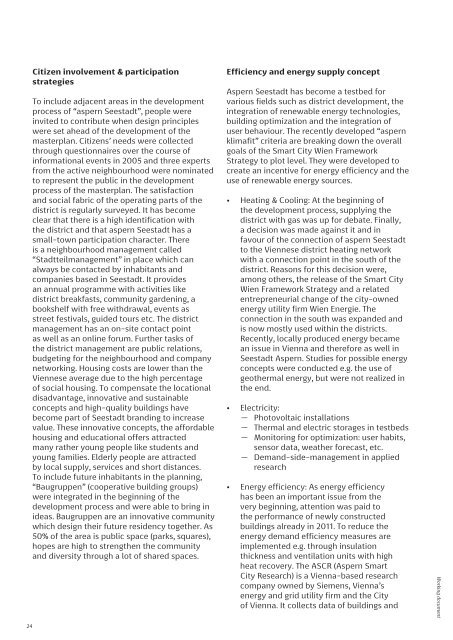Cities4PEDs Atlas_November 2021.pdf
Atlas - From 7 case interviews to recurring strategies and PED relevant aspects
Atlas - From 7 case interviews to recurring strategies and PED relevant aspects
- No tags were found...
Create successful ePaper yourself
Turn your PDF publications into a flip-book with our unique Google optimized e-Paper software.
Citizen involvement & participation<br />
strategies<br />
To include adjacent areas in the development<br />
process of “aspern Seestadt”, people were<br />
invited to contribute when design principles<br />
were set ahead of the development of the<br />
masterplan. Citizens’ needs were collected<br />
through questionnaires over the course of<br />
informational events in 2005 and three experts<br />
from the active neighbourhood were nominated<br />
to represent the public in the development<br />
process of the masterplan. The satisfaction<br />
and social fabric of the operating parts of the<br />
district is regularly surveyed. It has become<br />
clear that there is a high identification with<br />
the district and that aspern Seestadt has a<br />
small-town participation character. There<br />
is a neighbourhood management called<br />
“Stadtteilmanagement” in place which can<br />
always be contacted by inhabitants and<br />
companies based in Seestadt. It provides<br />
an annual programme with activities like<br />
district breakfasts, community gardening, a<br />
bookshelf with free withdrawal, events as<br />
street festivals, guided tours etc. The district<br />
management has an on-site contact point<br />
as well as an online forum. Further tasks of<br />
the district management are public relations,<br />
budgeting for the neighbourhood and company<br />
networking. Housing costs are lower than the<br />
Viennese average due to the high percentage<br />
of social housing. To compensate the locational<br />
disadvantage, innovative and sustainable<br />
concepts and high-quality buildings have<br />
become part of Seestadt branding to increase<br />
value. These innovative concepts, the affordable<br />
housing and educational offers attracted<br />
many rather young people like students and<br />
young families. Elderly people are attracted<br />
by local supply, services and short distances.<br />
To include future inhabitants in the planning,<br />
“Baugruppen” (cooperative building groups)<br />
were integrated in the beginning of the<br />
development process and were able to bring in<br />
ideas. Baugruppen are an innovative community<br />
which design their future residency together. As<br />
50% of the area is public space (parks, squares),<br />
hopes are high to strengthen the community<br />
and diversity through a lot of shared spaces.<br />
Efficiency and energy supply concept<br />
Aspern Seestadt has become a testbed for<br />
various fields such as district development, the<br />
integration of renewable energy technologies,<br />
building optimization and the integration of<br />
user behaviour. The recently developed “aspern<br />
klimafit” criteria are breaking down the overall<br />
goals of the Smart City Wien Framework<br />
Strategy to plot level. They were developed to<br />
create an incentive for energy efficiency and the<br />
use of renewable energy sources.<br />
• Heating & Cooling: At the beginning of<br />
the development process, supplying the<br />
district with gas was up for debate. Finally,<br />
a decision was made against it and in<br />
favour of the connection of aspern Seestadt<br />
to the Viennese district heating network<br />
with a connection point in the south of the<br />
district. Reasons for this decision were,<br />
among others, the release of the Smart City<br />
Wien Framework Strategy and a related<br />
entrepreneurial change of the city-owned<br />
energy utility firm Wien Energie. The<br />
connection in the south was expanded and<br />
is now mostly used within the districts.<br />
Recently, locally produced energy became<br />
an issue in Vienna and therefore as well in<br />
Seestadt Aspern. Studies for possible energy<br />
concepts were conducted e.g. the use of<br />
geothermal energy, but were not realized in<br />
the end.<br />
• Electricity:<br />
— Photovoltaic installations<br />
— Thermal and electric storages in testbeds<br />
— Monitoring for optimization: user habits,<br />
sensor data, weather forecast, etc.<br />
— Demand-side-management in applied<br />
research<br />
• Energy efficiency: As energy efficiency<br />
has been an important issue from the<br />
very beginning, attention was paid to<br />
the performance of newly constructed<br />
buildings already in 2011. To reduce the<br />
energy demand efficiency measures are<br />
implemented e.g. through insulation<br />
thickness and ventilation units with high<br />
heat recovery. The ASCR (Aspern Smart<br />
City Research) is a Vienna-based research<br />
company owned by Siemens, Vienna’s<br />
energy and grid utility firm and the City<br />
of Vienna. It collects data of buildings and<br />
Working document<br />
24


















